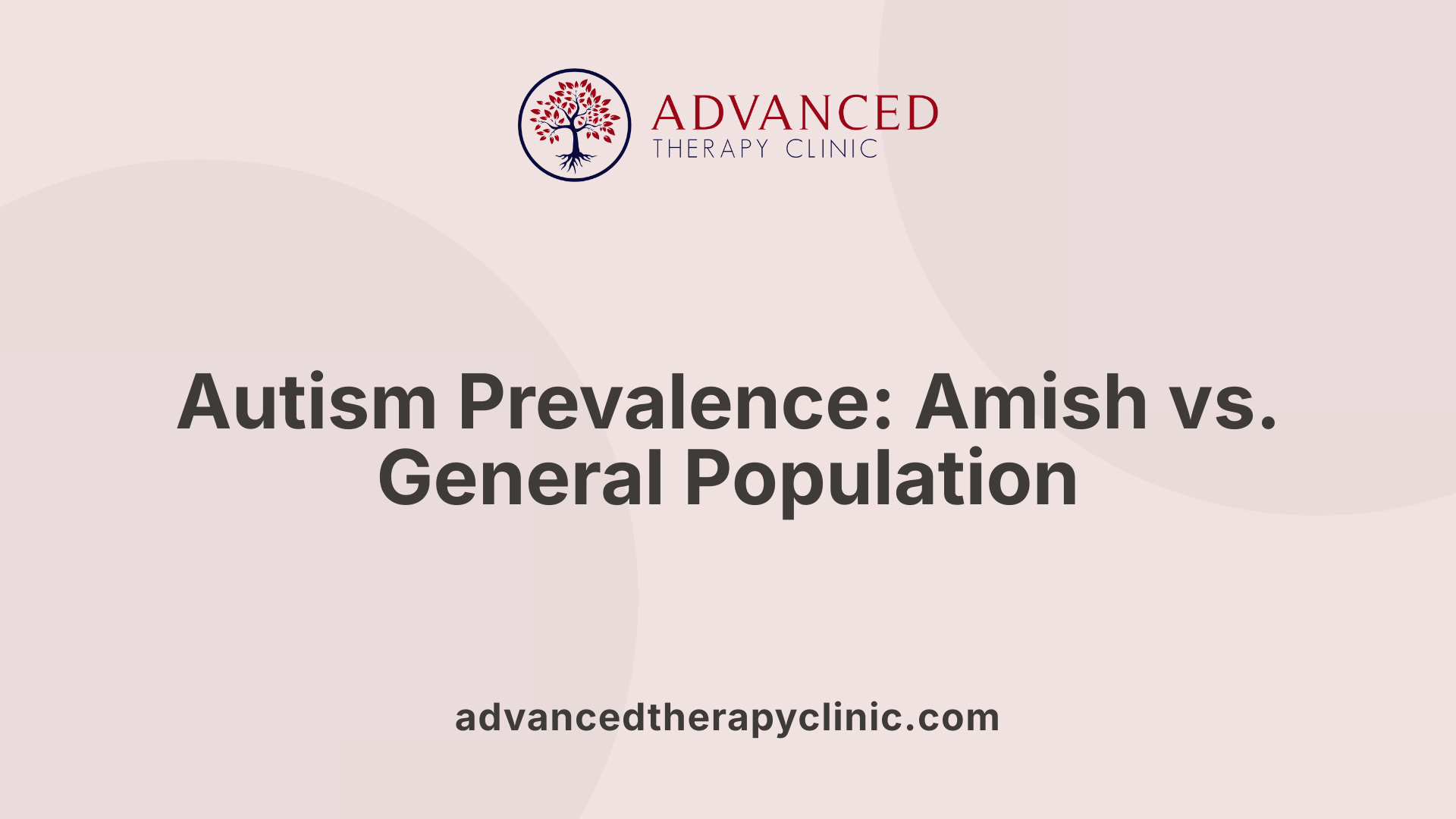Do Amish Kids Get Autism?


Understanding Autism in the Amish Community
Autism spectrum disorder is a complex neurodevelopmental condition observed in diverse populations worldwide. However, popular beliefs sometimes question its presence in unique communities such as the Amish. This article explores current knowledge about autism prevalence among Amish children, addressing genetics, cultural factors, and healthcare nuances shaping autism diagnosis in this community.
Evidence of Autism within Amish Communities

Do Amish Children Get Diagnosed with Autism?
Yes, autism is acknowledged within the Amish community. Contrary to some misconceptions that autism is absent or extremely rare among Amish children, there are both anecdotal reports and expert confirmations supporting its presence. Genetic epidemiologist Braxton Mitchell, who works with the Amish Research Clinic, has affirmed the occurrence of autism in Amish populations.
The recognition of autism in Amish communities is important given their unique cultural context. While community members may traditionally manage health issues internally and seek medical care mostly for urgent matters, autism is nonetheless identified and diagnosed. This acknowledgment challenges any notion that autism is exclusive to or significantly more prevalent in non-Amish populations.
These findings help expand awareness that Amish children, like children in the general population, can have autism. Expert opinion and community reports align, emphasizing that autism is part of the health landscape in Amish communities.
Prevalence Rates: Amish vs. General Population

What is the prevalence rate of autism among Amish children?
A comprehensive 2010 study screened 1,899 Amish children from Holmes County, Ohio, and Elkhart-Lagrange County, Indiana. This research found an autism prevalence rate of about 1 in 271 children. This figure is notably lower than the estimated general population prevalence at the time, which stood around 1 in 91 children.
How do autism prevalence rates compare between the Amish and the general population?
The study’s findings suggest that autism is less frequently diagnosed among Amish children compared to the broader population. However, this discrepancy does not necessarily equate to a genuinely lower occurrence of autism within Amish communities.
What impact do cultural factors have on reported autism prevalence?
Cultural norms among the Amish likely play a significant role in these reported differences. The Amish generally manage health issues within the community and are less inclined to seek formal medical assessments unless problems are severe. This practice might lead to underdiagnosis of autism and underrepresentation in prevalence data. Additionally, variations in screening methods and response patterns affected by cultural perspectives complicate direct comparisons with general population figures.
Overall, while the 2010 study provides valuable insights, it underscores the need for culturally sensitive, standardized assessment approaches to better understand autism prevalence in Amish populations relative to others.
Challenges in Accurate Diagnosis and Screening in the Amish

Why might autism be underdiagnosed in Amish communities?
Autism may be underdiagnosed among Amish children largely due to cultural norms. The Amish community traditionally prefers to manage health issues internally rather than seeking professional medical care unless absolutely necessary. This approach means many developmental concerns, including signs of autism, might not reach medical professionals or be formally documented.
Limited healthcare access
The Amish also experience limited access to healthcare services. Geographic isolation, reliance on traditional lifestyles, and a preference for community-based solutions mean that children with subtle or moderate autism symptoms might not undergo thorough screening or receive formal diagnoses.
Handling health internally rather than professional medical care
Because the Amish community often addresses health concerns within their own social and familial circles, there is less interaction with external healthcare providers who use standardized screening methods. This reduces the chances of identifying autism early and accurately through recognized medical assessments.
Together, these factors contribute to a likely underdiagnosis of autism in Amish populations compared to national averages. While a 2010 study screening nearly 1,900 Amish children found an autism prevalence of about 1 in 271, this rate is lower than the approximate 1 in 91 reported in the general population at that time. Such disparities highlight the need for culturally sensitive and accessible screening practices to better understand and support Amish children with autism.
Genetic Insights and Hereditary Factors in Amish Autism Cases
Are there known genetic factors related to autism in Amish children?
Yes, there are significant genetic factors associated with autism among Amish children. A 2009 case report identified a specific genetic defect linked to autism within this community, highlighting a hereditary component. This finding suggests that autism in Amish children may often have a genetic origin rather than being solely influenced by environmental factors.
Moreover, Amish children are known to have higher rates of rare inherited conditions. Studies also show connections between autism and epilepsy in Amish populations, implying overlapping genetic influences for these neurological disorders. These genetic insights stress the importance of examining hereditary aspects when studying autism in Amish communities.
Understanding these genetic links can help guide future research and improve diagnostic and treatment strategies tailored to the unique genetic landscape of the Amish population.
Need for Standardized Autism Assessment Across Populations

Why is it difficult to compare autism rates in Amish children with the general population?
Comparing autism rates between Amish children and the general population is challenging due to multiple factors related to data limitations and cultural differences. Current information on autism prevalence in the Amish community is scarce and primarily derived from a 2010 study that screened about 1,900 Amish children in Ohio and Indiana. This study found a prevalence rate of approximately 1 in 271 children, which is significantly lower than the general population estimate of 1 in 91 from the same period.
One major issue affecting direct comparisons is the variation in screening methods. The Amish community often handles health concerns internally and seeks professional healthcare primarily for urgent matters. This cultural tendency results in potential underdiagnosis and fewer formal screenings for developmental disorders like autism. Consequently, standard screening tools used in the general population may not be as effective or applicable in Amish settings, leading to underreporting.
The differences in cultural perceptions and reporting also influence the accuracy of autism prevalence figures. Amish families might respond differently to screening assessments due to their unique lifestyle and healthcare-seeking behaviors, which could skew results.
Given these obstacles, there is a pressing need for culturally adapted and standardized autism assessment tools. Such tools would ensure more reliable data collection, enabling accurate comparisons of autism prevalence across diverse populations. Developing sensitive screening instruments tailored to the Amish community would help identify cases more effectively and provide a clearer picture of autism's presence and genetic factors within this group.
Recognizing Autism in Amish Communities: Awareness and Research Imperatives
Autism does occur among Amish children, as supported by scientific studies and expert observations. Although prevalence rates appear lower than in the broader population, this discrepancy may stem from cultural practices, underdiagnosis, and screening challenges. Genetic factors unique to the Amish population also contribute to autism's manifestation. Enhancing autism awareness, improving culturally sensitive diagnostic protocols, and expanding research efforts are vital to better understand and support autistic individuals within the Amish community and beyond.
References
Recent articles

Expressive Speech Delay 2-Year-Old
Understanding and Addressing Expressive Speech Delay in Toddlers

How Speech Recognition Works
Unlocking the Power of Speech Recognition in Therapy and Healthcare

Autism and Head Size
Understanding the Complex Relationship Between Autism and Head Size

Occupational Therapy in Autism
Enhancing Independence and Quality of Life Through Occupational Therapy in Autism

Do Autistic People Understand Sarcasm?
Navigating the Nuances: Understanding Sarcasm and Social Communication in Autism

Autism Routines
Crafting Effective Daily Structures for Children with Autism

